Impressionist Sculptures of Auguste Rodin and Edgar Degas
Info: 12659 words (51 pages) Dissertation
Published: 22nd Dec 2021
Tagged: ArtsInternational Studies
1 Introduction
The nineteenth century art world was dominated by the Salon and academic arts. The Impressionism movement emerged in the late nineteenth century, challenging the established conventions. The artists of the movement, the Impressionists, were most known for their depiction of contemporary subject matter captured as a fleeting moment, their new approach to light and colours and techniques. Impressionism, however, is not to be strictly defined as a certain technique or aesthetic. Impressionism is most often related to the art of painting.
It is very rarely that it is thought of to be discussed in the art of sculpture. Indeed, it could appear absurd for the general public, when trying to put sculpture in the context of the Impressionism movement, for Impressionism very often mistaken as a sort of colour theory, style, and technique. However, I would argue that the essence of Impressionism is most effective and expressed to its fullest potential in sculptures, for when boiling down to the very core value, Impressionism is about “movement, spontaneity, and light”.[1]
In chapter 2, the history the Impressionism movement in its context as well as its definition in sculpture will be discussed.
In chapter 3 and 4, we will be looking into Auguste Rodin and Edgar Degas’ work in relation to Impressionism.
Auguste Rodin is considered one of the greatest sculptors in the history of art, and is regarded as “the father of modern sculpture.” [2] He did not identify himself as an Impressionist, yet his unprecedented representation of forms and movement and the way he utilised light to bring his work alive made it appropriate to refer to him as an Impressionist sculptor (note that Rodin is both an impressionist and an expressionist sculptor).
Edgar Degas on the other hand, was one of the founding members of the Impressionist group, however he denied the label and preferred to be called a realist. Degas was a painter with great fascination of ballet dancers and movement, and has only ever exhibited one sculptural piece in his life.
The main aim of this thesis is to discuss Rodin and Degas’ sculptural works, understanding the making of the selected pieces and the relationship they have with Impressionism. Besides individual research of the two artists, comparison between the two will be carried on in chapter 5 along with the conclusion of the thesis.
2 Impressionism in France
Impressionism is the first modern art movement in art history. We now see Impressionism as a certain style or school where artists depict a fleeting moment with bright prismatic colours and broken brush strokes, and the movement as a revolt against the established art world during the nineteenth century, where the Academy and the Salon dominated the art world, determining what was considered real and good “art”. However, the formation of the now so called “Impressionism” is far more profound than a stylistic pursuit, and it should not be defined by specific painting technique or aesthetics. In this chapter, we will discuss the history of how the Impressionism movement emerged in France in the nineteenth Century as well as how Impressionism is defined in the art of sculpture.
2.1 Nineteenth Century Academy Art and Realism
From the late-eighteenth century to the mid-nineteenth century France, the Académie des Beaux-Arts (The Academy of Fine Arts) was the most significant society of professional art, and had a virtual monopoly on public taste and official patronage[3]. The institute defined and dominated the established art world, where artists followed Neoclassicism and Romanticism styles and establishing “Academism”. Academic artists sought for depiction of classical and historical scenes with smooth and artificial contouring in achieving an idealised, sublime image of the characters- all with perfect autonomy, smooth and varnished- seeing a generalisation of human figures (Figure 2.1).
Paintings and sculptures of dramatic, passionate historical scenes and that of carrying strong symbol of heroism, religion, and mythology were the most favoured. The Salon was the art exhibition held by the Académie des Beaux-Arts where a jury of artists from the Academy chose the artworks that were eligible to show as well as awarding medals. The Salon was, before the first Impressionist exhibition in 1874, the only exhibition where artists could show, find patronage, and sell their artworks, therefore most artists longed for opportunities to show in the exhibition in the nineteenth century.
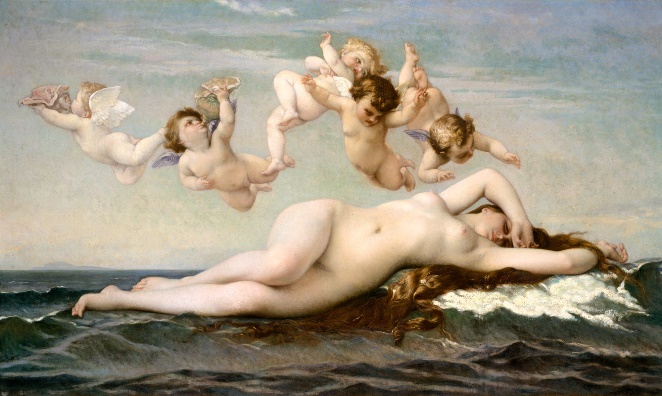
Figure 2.1 Cabanel, “The Birth of Venus”. 1875
The idealised, the rich, the holy, the royal, the extraordinary- indeed, subject matters of popular among the academic art world was far from the ordinary and the reality, not to mention the poor and unprivileged. This preference of departing from reality is in fact supporting the emperor Napoleon III, who took over the country illegally and started a dictatorship. The Salon and the academy answered directly to the emperor, and therefore projecting the ideology of the government as well as their support for the government through everything it presented.
In the 1840s, artists lead by Gustave Courbet (1819-1877) “sought to convey a truthful and objective vision of contemporary life”[4] as opposed to the then popular historical subject matters, calling themselves the “Realists”. “Realism emerged in the aftermath of the Revolution of 1848 that overturned the monarchy of Louis-Philippe and developed during the period of the Second Empire under Napoleon III.
As French society fought for democratic reform, the Realists democratised art by depicting modern subjects drawn from the everyday lives of the working class.” [5] The Realists depicted scenes of the contemporary life, painting ordinary people and even the poor at large scales that were considered only fitted for history paintings and themes such as goddesses and heroes. They were against the idealised, superficial, and overworked academic style, abandoning the history and classical themes and the generalisation of figures, and basing their artwork on direct observation in achieving their goal of portraying the “truth” (Figure 2.2).
As Courbet stated in 1861, “painting is an essentially concrete art and can only consist in the representation of real and existing things.”[6] Realist artworks were heavily politically charged, as artists (especially Courbet) were seeking democracy in their professional field, while protesting and criticising the government through their own media. Their flouting of artistic conventions and subjects they chose to depict were interpreted by some people as anti-authoritarian threat against the political regime (Figure 2.3). Despite the Realist paintings were not of the preferred academic style, the Salon still accepted their works repeatedly. The Realism movement played an important role in inspiring the late nineteenth century Impressionism.
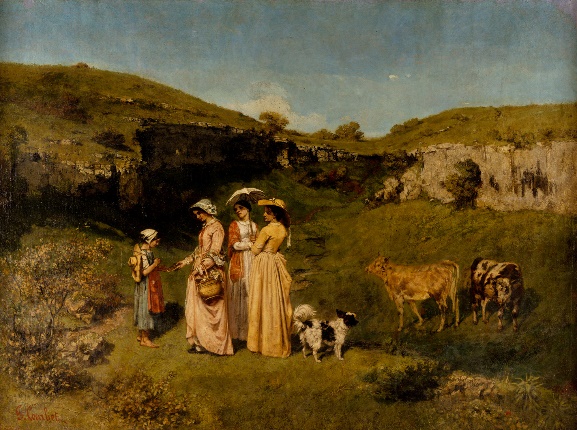
Figure 2.2 Courbet, “Young Ladies of the Village”. 1851-1852
In this painting, we see three middle class women offering charity to a young cowherd. When displayed at the Salon in 1852, it was brutally criticised to be tasteless and clumsy for the “unflattering” subject matter and the violation of the academic perspectives, composition and techniques.
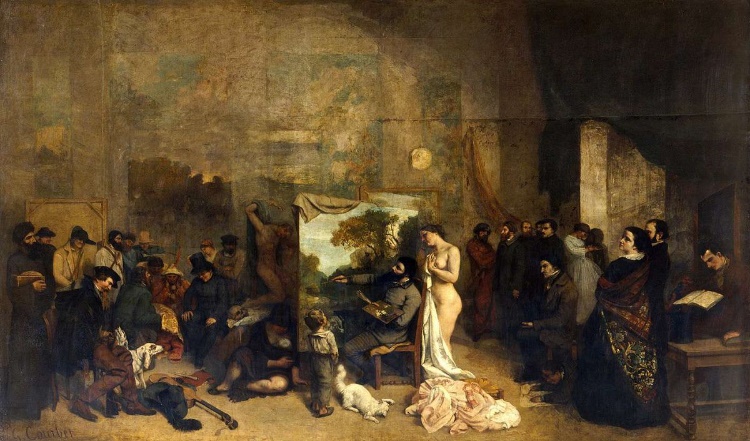
Figure 2.3 Courbet, “Artist’s Studio, a real allegory summing up seven years of my artistic and moral life Between 1854 and 1855”.
Courbet exhibited this painting in his “Pavilion of Realism” he erected right in front of the Salon in 1855 along with 40 other paintings right in front of the Salon. This piece was the centre piece of his pavilion. As its title suggests, the painting projects Courbet’s social life and his political stance.
2.2 The impressionists
With the rapid industrialisation and the raise of bourgeoisie class, the city of Paris saw new kinds of leisure life emerging. The erection of new modern architecture, squares and venues for entertainment brought the new attitude of “escapism” and “consumerism” to the society, where people were encouraged to prioritise entertainment and materials over politics, which was in fact a strategy used by Napoleon III since the 1860s in subtly oppressing the population, masking authoritarian with economic prosperity and modern fun.[7]
The railways made it convenient for one to reach the countryside for weekend relaxation such as boating activities and picnics; cafés become some of the most popular gathering places for citizens to exchange ideas and socialise, and theatrical entertainment saw a soaring popularity. Sharing the same attitude as the Realists, a group of artists soughed to combat the established Salon art which they believed to be “false” by depicting the real world- the modern life and activities. They held independent exhibitions between 1874-1886, and gained the name “Impressionists”.
These artists however, did not inherit the violence and heavy political quality of the Realism artworks. These artists, however, despite sharing the same attitude towards the Academic art world and Salon, did not come together because of a certain “style” or “technique”, but were, initially, merely united by their independence from the Salon.[8] The now widely known “style” of Impressionism developed and matured throughout this movement, but we must not forget that a lot of the Impressionist artists possessed high individuality in terms of their own technique and approach towards their shared interest.
We will however, discuss Impressionism in a more general sense. “The Impressionists do not want to reproduce objects as we believe them to be from viewing and feeling them, but only their actual appearance. By our sensitivity… Impressions are transitory, passing either because of the changing condition of air and light or because the reasons for these changes are in themselves variable.”[9]The idea of Impressionism is most well understood as capturing a fleeting moment. The interest of “time” differs greatly from that of any previously established art styles where artists reproduce the ideal, attempting the permanent and the eternal.[10]
In capturing the fleeting moment, the glance, a great spontaneity in technique is clearly visible in Impressionist work- the short, broken brush strokes, lack or clear outlines of the figures, and unblended colours- it was drawing as well as painting, something in between as sketch and a complete, polished piece of painting, which attracted a lot of negative criticism at the time. Claude Monet (1840-1926)’s Impression, Sunrise. (Figure 2.4) exhibited in the first Impressionist exhibition in the 1874 was the piece that gained the group and the movement their names basing on Louis Leroy’s accusation of the piece being merely an impression of the artist instead of a finished piece of work.[11] When approaching the aim of depicting the reality and achieving accuracy, the Impressionists took the matter to another level by looking beyond the choice of subject matter and incorporating scientific discovery of the structure of light and the constitution of colours in their application and techniques[12].
Classically trained painter Édouard Manet (1832-1883) was considered the first artist to start the daring exploration of colours, which later became one of the most important qualities of the Impressionist paintings. Manet abandoned the classical technique of artificial contouring of the human and animal figures, the varnish used to tone down the vibrancy in classical paintings, and soughed to paint what one actually perceived through the retina and what colours actually exist in the nature. This means that shadows no longer play a modelling role in paintings, but has its own colour value, releasing colours from being merely an add-on and gave them their own identities (Figure 2.5). As Hartlaub said in his Impressionists in France, “If… one desired to paint only what one really sees, what actually affects the retina, and not what we now about the objects, then the shadows lose their depth- indicating function; one sees them not in their greater darkness, black, grey or brown but as having colour values of their own, which, as in a carpet, stand out beside the brightness on the same plane. One sees the colours all the more in the shadows, especially the blue, as one neglects their modelling function.”[13]
The truth of colours and shadows, for the Impressionist artists, was in a sense science- direct observation of the nature- explaining the use of unblended, vibrant prismatic colours, and the rather “flat” appearance of the figures when compared with classical, or even Realist art. “Impressionism is also avant-gardism.”[14] The daring attitude of the artists, their innovation in techniques, and the shock value it had towards the nineteenth century society is just as that of our shocking modern art of the 21st century.

Figure 2.4 Manet, Music in the Tuileries Gardens. 1862
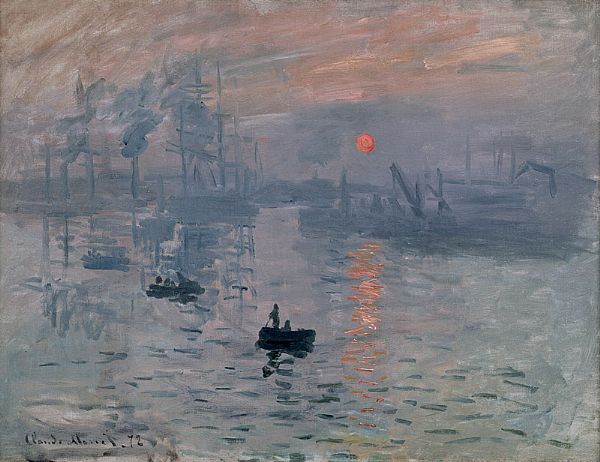
Figure 2.5 Monet, Impression, Sunrise. 1872
2.3 Defining Impressionism in Sculpture
The Impressionism as we know it, is mostly discussed around the art of paintings due to its dominant character of vibrant colours. Some even directly think of “Impressionism” as technique related to an approach to colour.[15] However, Selz stated in his book Modern Sculpture: Origins and Evolution that, “Impressionism involved a new theory of the painter’s vision, of his subjectivity, a new mode of expression based on an equivalence of colour and light. It cannot be strictly defined in terms of a direct relationship between aesthetics and technique as expressed in the work of all the painters of the group, for in several ways, these painters differed distinctly from one another.”
It is made clear that Impressionism should not be simply defined as a certain technique, therefore I think it is more fitting when trying to translate “Impressionism” in the art of sculpture, to define it based on the three main principles behind the Impressionist movement (which are most evident in Claude Monet’s work): movement, spontaneity, and light.[16] Sculptures of Auguste Rodin (1840-1917), Medardo Rosso (1858- 1928), and Edgar Degas (1834- 1917) embodied the essence of the Impressionism in their own ways. In the next two chapters, we will be looking closely into Auguste Rodin and Edgar Degas’ works and further discuss their relationship with Impressionism.
3 Auguste Rodin (1840-1917)
3.1 Rodin and Impressionism
Auguste Rodin is the father of modern sculpture and is considered both and Impressionist and an Expressionist sculptor[17] while he identified himself as a naturalist. The relationship Rodin and Impressionism have is not a direct, obvious one from a historical stand point for he was never a part of the group, neither did he take part in the Impressionist exhibitions. Rodin was born in a working-class family in Paris in 1840. He was enrolled in the School of Mathematics and Design by his father in hope that Rodin would be able to learn to become some sort of craftsman in order to earn his living. Rodin’s three failed attempts to join the École des Beaux-Arts spared him from the rigid Academic training, and lead him to take on a six- year apprenticeship under the successful decorative sculptor Carrier- Belleuse (1824- 1887) from 1864 to 1870.[18]
In 1875, Rodin travelled to Italy, where discovered the work of Michelangelo. Rodin was profoundly inspired and influenced by the work of Michelangelo, and stated that Michelangelo taught him principles entirely opposite from the one he’s been taught, liberating him from academic methods, and helped him discover the inner life of the human figure and its individuality.[19] Rodin’s passion in the study of ancient and Renaissance sculpture In Italy helped him to rediscover the renaissance traditions- which had almost died at the hands of academic formularizers- as basic for his own work.[20] This, along with his personal ideas, quality in terms of form and power, and innovative techniques (which we will be discussing in further details in chapter 3.2), demonstrates Rodin’s ability to “combine sensitive modelling with an almost classical rigor”. [21]
To quote Rodin, “Sculpture is the art of the hole and the lump, not the straightness of smooth faces without modelling… The public, which has been perverted by academical prejudice, confounds art with neatness or spruceness.” [22] Rodin’s modelling technique where he broke up planes in achieving “flickering effect of light and shadow” is in a way comparable to the “broken facets of colour of the Impressionists”, however, there is far more than just the “transitory impact of light” that he shared with the Impressionist painters.[23] Rodin’s opposition to academic tradition in his sensibility to his technique of expression- where he handled the medium with extraordinary freedom and freshness, with an approach to reality which was stronger and more intimate- is one of the key factors that linked him to Impressionism, for Impressionism, besides “movement, spontaneity, and light” discussed in chapter 2.3 (which Rodin’s work strongly embodied), also implies “revolution in the representation of form”.[24]
However, we cannot consider Rodin’s sculptures as a result of the Impressionist movement despite the movement has, as Selz suggested, “undoubtedly encouraged him in the revolutionary direction he had already begun to follow”.[25]
3.2 Rodin and Sculpture
In his book, Modern Sculpture: Origins and Evolution, Selz divided Rodin’s work into two categories of technique: clay or plaster and marble. We are to discuss only his clay and plaster works for it is most true to Rodin as an artist in terms of his vision. Rodin modelled clay directly with his hands, revealing “the freedom and sensitivity of touch which makes each surface.”[26] Most of Rodin’s finest works were modelled directly in clay, including The Walking Man, The Burghers of Calais, and The Gates of Hell.
Rodin is known to work on the clay while fixating his eyes on the model. He examined as many possible profiles of the model, sculpting his work in different lighting- from the brightness of the day to candle light- in pursuit of vitality of surface of his work. He left traces of his touch to “register his own act of making in the object itself”.[27] Through Rodin’s powerful manipulation of the material, when looking at Rodin’s work, especially in comparison to the Academic sculptures (which Rodin referred to as “empty dolls that seem frozen in death”), the torment and passion along with the movement of the human body and its flickering effect of lights and shadow draw the audience in the split-second Rodin captured: feeling the movement, the thought, and the emotions as well as experiencing the process of the making of the sculpture.
Rodin’s work “generate a real electric current, transmitted by the sculptor’s hands to his materials, suggest that for Rodin, sculpture was not only an idea which assumed concrete form, but a physical thing, the achievement of a deep and indissoluble harmony between his hands- the creators- and the object created.”[28] Rodin is the master of not only capturing and sculpting movement, but also infusing life and meaning in it through his handling of the clay, his presence and the process he made visible, and the play of the light. Just as Selz stated, “For Rodin, everything was movement; every feeling, every passion had its corresponding gesture. The state of rest, in contradiction to the expression of life, could contribute nothing to his art. For this reason, he liked to let his models, male and female, move about freely and in the nude through his studio while he worked. Man, in Rodin’s sculpture is, therefore, essentially man- in- movement. Rodin’s humanity is swept by the wildest and most excruciating passions, by movement chosen for its ardour, tension, and violence, so that gesture becomes a sort of language dominated by the cry.”[29]
3.2.1 The Bronze Age and the Development of Personal Style
During his stay in Brussels and Rome, Rodin had already begun sketches and studies for his first famous work, which was later known as The Bronze Age (Figure 3.1). His fascination for ancient and renaissance sculptures drew him to closely study the Nature, hence his identifying himself as a “naturalist”. Furthermore, in his talks on Art, Rodin analysed how Michelangelo’s works differ from that of the Greeks: Michelangelo translated and expressed the “quiet charm obtained by movement through four planes in a Greek statue” through “a reduction to two planes, transformed into a movement which gives the gesture both violence and constraint”. Beyond the Nature and the realism, this “anxious energy” Michelangelo’s works embodied is what Rodin continued to make visible in his own work for the years to come. [30]
The Bronze Age was completed upon his return to France and the first plaster cast was shown in the Salon in Paris in 1877. The life-size, deceptively realistic sculpture of a solider in the nude was so far removed from the academic convention, which provoked criticism and accusation of moulding directly upon the live model. This accusation, as Getsy suggested in his book Rodin: Sex and the Making of Modern Sculpture, haunted Rodin all his life despite his later success, which lead him to model bodies in either larger (Saint John the Baptist Preaching) or smaller scales (The Gates of Hell), and leaving evidence of his touch on his sculptures.
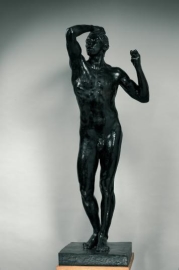
Figure 3.1 Rodin, The Bronze Age. 1877
“… I have to learn to reproduce surface, which means everything that vibrates on the surface: beauty, or love, or passion, or life…”[31] “I have always tried, to render inner feelings through muscular movement.”[32] Rodin’s personal style and methods were not yet fully developed and realised at this point of his career, and the accusation The Bronze Age received, I believe, played crucial role in his realisation of style, for it pushed him to go beyond the nature itself and express more profoundly the emotions, the power, the inner feelings basing on his direct observation of the nature.
3.2.2 The Gates of Hell
3.2.2.1 Fragmentation
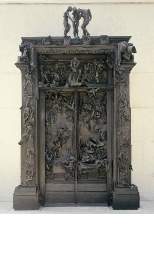
In 1880, Rodin received state commission to create the main gate for the Museum of Decorative Arts in Paris. The building was never built, however, the project, which was eventually called The Gates of Hell became a life-long project for Rodin, which he never stopped working on, and from which many of his well- known freestanding sculptures such as The Thinker derived from.
The Gates of Hell was never finished, and it remained uncast and disassembled till Rodin’s death.[33] The Gates of Hell (Figure 3.3) represents Rodin’s major innovation in sculpture: fragmentation, or as Getsy named it, “recombinatory practice”[34], for he carried out this practice most extensively throughout the project.
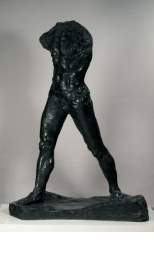
Due to the large size of the project, it is inevitable for the original clay models to dry and crumble during the process, therefore Rodin would cast each figure individually in plaster several times in preserving them for further study and later assemblage. However, besides this obvious purpose, Rodin also treated these plaster casts as “raw material for sculpture” by “breaking them apart, recombining them, and further multiplying them.”[35]
Throughout his career, Rodin continuingly worked with fragmentation in exploring new forms and expression, both on The Gates and on his other projects. One of his most highly regarded piece, The Walking Man (Figure 3.2), was the prime example of this recombinatory practice where he combined two fragments of different styles and attitudes in 1899: an old torso fragment (1870) found in his studio, and legs from a smaller scaled version Saint John the Baptist Preaching (1878). Selz analysed Rodin’s representation of the movement of walking, “the two contrasting attitudes of the legs suggesting two different periods of time, future and past, in illustration of a theory of movement which was frequently used in his sculpture [.]”[36]
3.2.2.2 Je Suis Belle: contortion and desire
“No Rodin sculpture is known until it is known in its adaptability.”[37] As mentioned, Rodin took the opportunity while working on The Gates of Hell to practice his recombinatory practice in exploring new forms, and many of his most celebrated works were results of his combining of different fragments. Rodin chose to depict Dante’s Inferno for The Gates. The theme of the project allowed Rodin to explore the human body in extreme form of contortion expressing suffering, lust, power, and tenderness. We are not to discuss The Gates of Hell as a whole due to its complexity (it contains 180 figures), but we will briefly discuss the general idea and the making of the project, as well as one of the two-figured group on the top right pilaster of the Gates - Je Suis Belle (I am Beautiful) (Figure 3.4).
Je Suis Belle, also known as The Abduction, Carnal Love, or The Cat.[38], is the combination of Crouching Woman (Figure 3.6) and the Falling Man (Figure 3.5), and the union existed as independent sculpture around 1882. The Crouching Woman (1880- 1882), also known as Lust, represents the dark, or even pornographic, sensuality Rodin expressed in some of his work.
The posture was contorted, exaggerated, and flagrantly immodest: the model’s legs were spread, exposing her genital, while her lips parted and touching her breast with one hand. The sexuality of the figure is so explicit and disturbing, “quasi- animalistic” and “often regarded as obscene because of the muffled violence that seems to emanate from the sculpture.” [39] The Falling Man (1882) is an anguish muscular figure with his back arched, representing “the cumulative human forces, cast upon the eternal emptiness of Hell”[40].
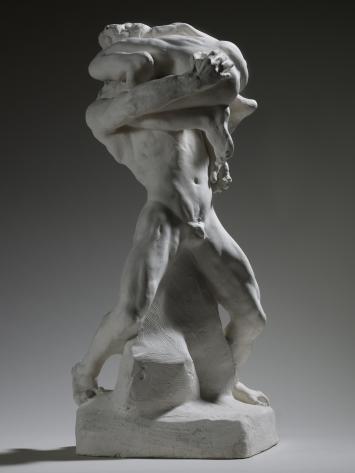
Figure 3.4 Rodin, Je suis belle. 1882
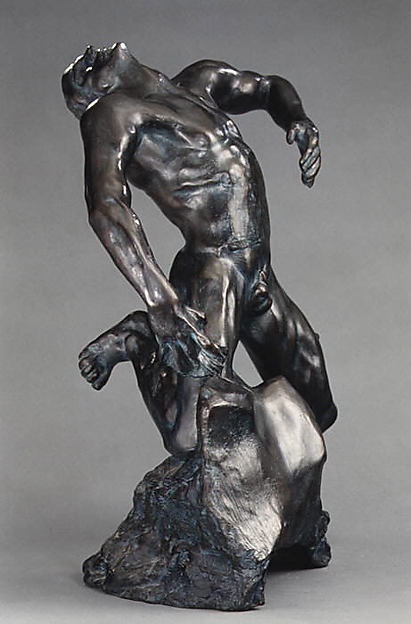
Figure 3.5 Rodin, Falling man. Modelled 1882, cast 1982
“With Je suis belle Rodin began to act on impulse and do whatever was necessary to reach a level of feeling.”[41] In the creation of Je suis belle, the two figures were balanced horizontally with the Falling Man holdingthe Crouching Woman, and modified in three dimensions. For example, the woman’s hand on her ankle was replaced with one that dropped down in eliminating the gap between two figures. The inner energy of the sculpture is brought to life especially in raking light, under which “the mass consists of ridges of sharp reflected light and dark undersides”.[42]
Je suis belle was exhibited at the Galerie Georges Petit in 1886, where critics stated that “No one has ever succeeded so well in expressing the savage onslaught of Desire and the furious cries of the flesh.” The piece was cast in bronze in 1887, with Baudelaire’s poem ‘Beauty’ from his Flowers of Evil inscribed on the base. [43]
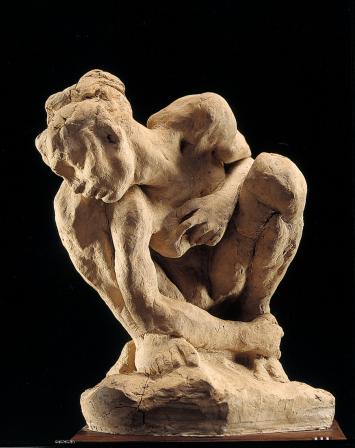
Figure 3.6 Rodin, Crouching Woman. 1880-1882
Both the Crouching Woman and the Falling Man appeared on The Gates of Hell more than once. The combined piece, Je suis belle, appeared on the upper part of the right pilaster, with the woman almost disappearing into the frame and her most provocative exposed backside deliberately hidden from the audience. In his placement, the balance between blatant and discreet is compounded. As Lampert stated, Je suis belle is not merely an “example of Rodin’s erotic fantasy his paring of images”, but a “paradoxical thing with a unity all of its own”.[44]
3.2.3 The Burghers of Calais
In 1884, while still working on The Gates, Rodin received the commission to create a monument for the town of Calais in commemorating the six men who volunteered to be sacrificed as ransom for their town to Edward III of England. The committee of Calais was thinking of erecting a heroic, allegorical statue of the leading Burghers Eustache de St Pierre, however, Rodin had different ideas. Rodin proposed to include all six men in his work, and instead of creating a heroic commemorating piece, he wanted to capture a moment during which the men were walking to the citadel with the key of the city and express their inner turmoil, the fear of facing their own deaths. Rodin also proposed for the pedestal to be removed so the sculptures can stand in the town square amongst the viewers in allowing the piece to be experienced from every angle, and the movement to be even more lively- this request, however, was denied by the committee of Calais. (Figure 3.7)
Rodin’s four- year research and work on the Gates by the time he received this commission in 1884, developed in him an attitude and working methods, which The Burghers of Calais more or less followed and benefited from. Rodin “had grown accustomed to deriving inspiration from quick sketches of the model in a moment of arrested action”. As the project progressed in scale and level of detail, beyond the time he allowed himself for “experimentation and chance,” he would “deliberately [separate] out ideas into individual statements.”[45] During the making of the Burghers, Rodin abandoned the accepted formulas for public monument- traditional vocabulary of allegorical symbols- in achieving the character’s individuality.[46] He modelled various body parts and assemblies them in different ways, modifying or discarding parts as well as constant reorientation and rearrangement until the project took its final form.[47] “First I made close studies after nature, like The Bronze Age.
Later I understood that art required more breadth- exaggeration, in fact, and my aim was then, after the Burghers of Calais, to find ways of exaggerating logically- that is to say, by reasonable amplification of the modelling. That, also, consists in the constant reduction of the face to a geometrical figure, and the resolve to sacrifice every part of the face to the synthesis of its aspect.”[48] Rodin’s understanding of the human body through his close study of the nature allowed him to exaggerate forms and features of the figures in achieving explicit expression of his characters’ inner energies without falling into being theatrical. It is a new kind of ‘realistic’ representation of figures. The Burghers of Calais is considered one of the most remarkable example that demonstrates his genius where each character as separate individual, bears immense tragic tension- the anguish, resignation and pain- that is made tremendously affective through their movements.
When put together, a “spatial and structural as well as an emotional dialogue” [49] is brought to life, which is the most powerful composition in conveying the theme. The Burghers was completed in 1889, and cast in bronze in 1895. To quote Selz on Rodin’s work as conclusion, “Those bodies quivering with life, those sensual lovers, those tormented groups, everything that emerged from his hands, found its justification in its evident truth. The statues can be seen from every angle, lighted in various ways, as Rodin himself was wont to do with a lamp or candle: each facet is interesting, so that we demand of the face, the hand, or the belly, no other reasons for being than that of having been sculpted for itself.”[50] Rodin’s practice- his handling of clay, his innovative methods, his “mysterious correlations between thought and gesture”[51], light, freedom, movement- earned him the credit of “[exalting] sculptures in their own right.[52]
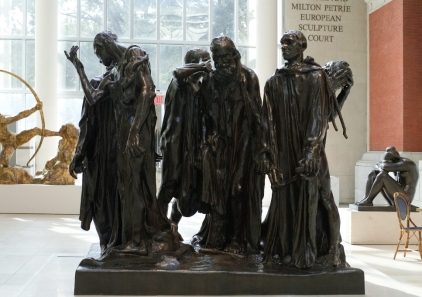
Figure 3.7 Rodin, The Burghers of Calais. Modelled 1884–95, cast 1985
4 Edgar Degas (1834- 1917)
4.1 Degas and Impressionism
Edgar Degas (1834- 1917) is considered by some one of the greatest Impressionist artists, yet there has been an on-going debate about whether he is to be considered a real Impressionist due to several aspects of his background and his work that differ from the majority of his contemporary Impressionist artists, moreover, Degas himself resisted to identify with the label of “Impressionist” and instead, preferred being considered a “Realist” or “Independent”. Degas came from a wealthy family of bankers, and received traditional Academic training from Louise Lamothe (who was a disciple of Jean- Dominique Ingres), who also sponsored him for entry into the École des Beaux-Arts in 1855 where Degas was registered for one semester.[53]
Degas also spent three years (July 1856 to April 1859) in Italy as a part of his training where he studied and copied works of old masters. Degas’ classical training built in him a very different attitude from other Impressionists where he saw himself as a draftsman, favouring artificial lighting and contouring over painting plein air landscapes, and claimed that there is nothing less spontaneous than his art.[54] Despite his classical training, Degas was known for being some of the most technically advanced artists in his time. He sought for new techniques and mediums in his art. He abandoned the Salon despite its ongoing prestige for dealer and avant- garde independent exhibitions in Paris and London in around 1870[55], and was one of the founding members of the group of artists who were later labelled as “the Impressionists”, and organised their independent exhibitions in Paris.
He found passion in depicting modern life, especially that of the theatre and female ballet dancers. Focusing on the ballet dancers allowed Degas to fully explore the human body, for ballet is all about the human figure and movement, which was his most familiar artistic interest. Degas represented dancers in almost all mediums, both two- dimensional and three- dimensional, ranging from paintings and pastels to sculptures.[56] He chose perspectives that are more personal for both himself and the dancers in achieving the idea of catching the subject matter unaware[57], in other words, movements and moment he captured were like that of a random glance, frozen and preserved with his chosen medium (Figure 4.1, Figure 4.2), which was the essence of the Impressionist movement.
Indeed, his background and techniques might suggest a vast difference between Degas and his fellow Impressionists, yet his intimate tie with the Impressionist movement is undeniable being one of the founders and organizers of the group’s exhibitions and its core members.[58] Furthermore, despite the differences in certain aspects, the quality his work embodies, especially that of his ability to capture fleeting moments, made “Impressionist” the best to describe Degas as out of all other art movements.
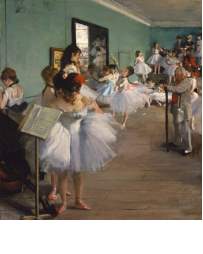
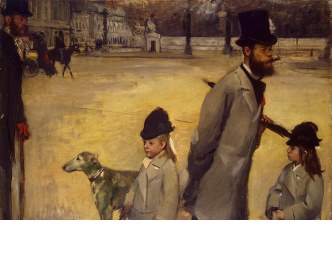
4.2 Degas and Sculpture
“Sculpture is usually treated as a minor and quirky facet of Degas’ prolific oeuvre. If not portrayed as the brilliant pastime or the last resort of a blind artist, it is described as prefatory, intended as studies for his two- dimensional work… Degas’ three- dimensional forms may have contributed to his two- dimensional work throughout his career, as most scholars argue; the whole certainly cross-fertilized in vital ways. Yet comparing a sculpture and a related painting, pastel, or drawing often emphasized their dissimilarities, suggesting Degas explored a single motif differently in different mediums.”[59]
Even though Degas is most known for his two- dimensional works of dancers, from his two- dimensional works, his strong interest in the three- dimensional reality is evident from how he “repeatedly rendered figures from various perspectives or focused on three- dimensional volumes in space and light”[60]. We are not to further discuss Degas’ two- dimensional works on ballet dancers, instead, we will be looking into some of his sculptural works. Despite the fact that Degas was rarely received a sculptor, for Degas, sculpture had always been a major activity, and it was a way of realising a need for precise construction which most of the Impressionists never experienced[61], setting him apart from the other Impressionists.
Degas has only ever exhibited one sculptural work: Little Dancer Aged Fourteen (La Petite Danseuse de Quatorze Ans) (Figure 4.3), and besides this one wax ballerina statuette, it wasn’t until Degas’ death in 1917 that the rest of his 150 small- scale (with the 38- inch Little Dancer being the only exception) sculptural work in wax, clay and plastiline were discovered in his studio, none of which were cast in bronze (only a few were cast in plaster).
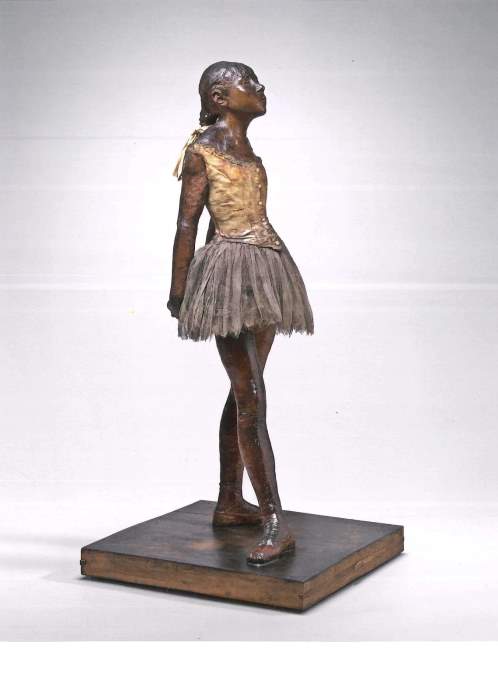
4.2.1 Little Dancer Aged Fourteen
4.2.1.1 Subject Matter
As discussed in previous chapter, “Impressionism is also avant-gardism.”[62]. Both the subject matter the artists chose to depict and the technique and aesthetic were shocking to the general public at that time, where people were used to the “beauty” and what is “appropriate” defined by Academic arts. Degas’ Little Dancer Aged Fourteen (1878- 1881)certainly fits the profile perfectly in delivering shock value.
First of all, the subject matter. Ballet dancers in the Opéra were not just associated with art, but they are also very often related prostitution (especially the younger dancers). The dancers were usually from the lowest social classes, and the gentlemen in top hats that were haunting many of Degas’ paintings of the ballet dancers, their customers. With ballet dancers already being a controversial subject matter, Degas took the matter to yet another level by choosing to sculpt a young, underage dancer, Marie van Goethem, in a very realistic manner, both in size and his choice of materials and techniques.
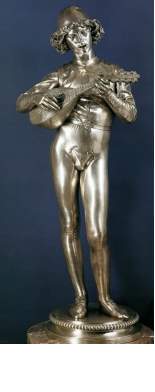
In the Academic art world, youth was in fact a popular subject matter, however, when working with “youth”, it was to celebrate the beauty, and childhood naivete. Taking Paul Dubois’ A Fifteenth- Century Florentine Singer (Figure 4.4) for example, the smooth, flawless young boy in bronze from a historical period playing musical instrument, was the kind of sculpture typically accepted and sought for in nineteenth century.
Instead of choosing some naïve, beautiful young girl from the past, Degas chose a teenage dancer at the Opéra. The young dancers in Opéra were admitted to the Opéra as students at the age of eight, and as early teenagers, they were either doing unpaid walk-ons or poorly paid minor roles. Due to their humble backgrounds and low income, the young dancers were often prostituted by their mothers, they “embodied the many vices and criminal tendencies long attached to the lowest classes and theatre world”, and instead of being seen as charming gamine or sexual victims, they were seen as calculating sexual predators. [63] Degas portrayed “youth” in such a different and controversial way that stirred up great criticism on morality in the theatre world. Furthermore, Degas chose to display the Little Dancer next to his drawings of some young criminals instead of paintings of dancers, as if he’s quietly indicating the kind of people a little dancer would usually be associated with in her life.
4.2.1.2 Materiality and Modelling Technique
Little Dancer Aged Fourteen was originally set to be exhibited on the 1880 Impressionist exhibition in Paris. However, Degas failed to finish the sculpture in time due to his decision to enlarge the size of the sculpture from his original plan and technical difficulties in making the sculpture hold up. The sculpture was eventually exhibited on the sixth Impressionist exhibition in 1881- a realistic, 2/3 life-size wax sculpture cladded in real bodice and tutu and wearing a wig of human hair, standing in a glass box.
The Little Dancer was resting in the fourth position with her hands clasped behind her back, arm stretching downwards. Her head tilted forward and upward, with her mouth slightly open and eyelids half-lowered.[64] Before he started sculpting, Degas utilised the tool that was most familiar to him- drawing- in studying and planning the sculpture (Figure 4.5). Since there are very few documentation and description on Degas’ sculptures including the Little Dancer, scholars relied heavily on the drawings and sketches found in his studio after his death in 1917 as primary source for their investigation on the artist’s work. Drawings of the little dancer showed that Degas studied the pose in multiple viewpoints, both clothed and in the nude.
Radiograph study (Figure 4.6) of the sculpture shows the complex internal armature: base metal rods wrapped with additional materials such as rope, wood, and wire. The armature was then permanently fixed and stabilised with a layer of clay added directly to the construction, ready for the exterior molten beeswax layer modelling. Paint brushes can be found throughout the structure as supports added during the modelling process.
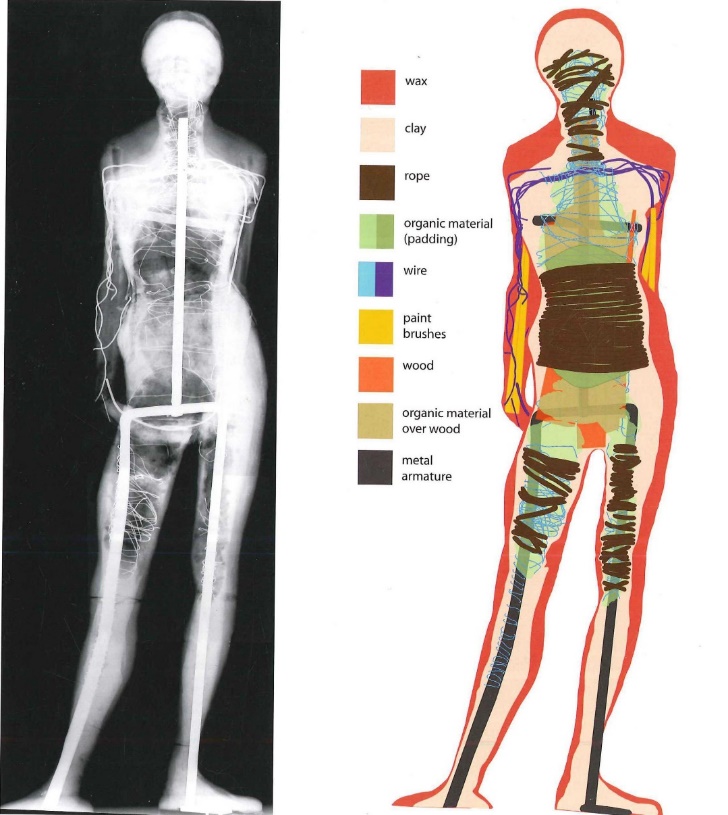
Figure 4.6 Radiograph study of internal structure
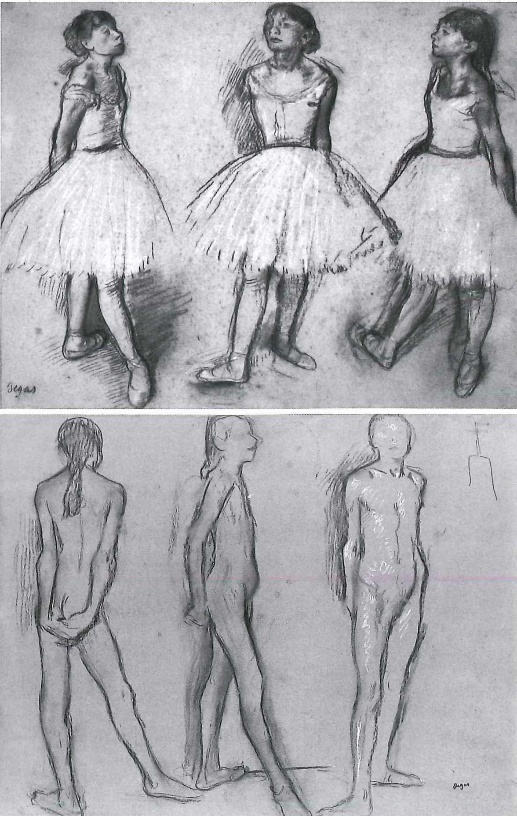
Figure 4.5 Degas, study drawings
Regarding materiality, it is obvious for painters to choose soft material such as clay or plaster as opposed to carving wood or stone for painters are accustomed to working in tractable pigments.[65] Wax was a very unconventional material for sculptures in the 19th century where most of the Academic sculptures were in bronze or marble. Wax as a modelling material allowed direct finger work, allows flexibility and adjustment. The colour and texture of the wax also gave the sculpture a much more realistic look of the translucency of the human flash, the softness, the fragility. Degas even rendered some parts of the wax (around ears and lips) to give it a pink tint, allowing an even more lifelike presentation[66]. The wax sculpture today has turned into a dark honey colour, and it is hard to define its original colour as Degas intended for it to be, but its lifelines is still very much alive. All of Degas’ wax sculptures found in his studio after his death were modelled with a sense of freedom and boldness, giving them the look of rough drafts despite the fact that they were actually rigorously constructed and studied. The Little Dancer was in fact far more polished and constrained in comparison to the rest of his sculptures.[67]
Finally, Degas’ decision on modelling the dancer in the nude and latter clad it with clothing and hair shows one of his unique strength in combining old techniques with innovation, as is very prominent in his two- dimensional works. The Little Dancer is wearing real bodice, tutu, and ballet slippers, dark blond Caucasian human hair with silk ribbon. The stocking however, was entirely modelled in wax, from which Degas created the illusion of fabric. All except for the tutu and the hair ribbon were covered in a layer of beeswax. Degas’ intension behind covering the attire and hair in wax is unknown, however, it is mostly believed by the scholars that the wax layer helped integrate the whole sculpture as a whole, and furthermore, it reminds the audience that despite the shocking realistic presentation, this is still a piece of art.
4.2.1.3 Criticisms, Interpretations and Bronze Cast
The Little Dancer provoked heated criticisms and mixed reviews from critics for it was so far removed from the nineteenth century Academic sculptures in almost every single aspect: the controversial subject matter, the choice of materials and colours, and the techniques. The sculpture was criticised to be ugly, and that it should be displayed in science laboratory as specimen due to its materiality and the fact that it was displayed in a glass cage. Degas’ decision on the anatomy where he decided to lower the dancer’s forehead and to make her jaw more pronounced was criticised to have made the girl “monkey like” and “primitive”. Interestingly, in the drawings of young criminals displayed alongside the Little Dancer, the same alternation of anatomy can be found as well. This could be linked to Degas’ fascination and study of science and how he related criminals to more primitive state of evolution.[68]
Despite the many negative responds, it also received positive feedbacks: for de Villars, it is “a future museum treasure that today’s public did not understand”; for Ephrussi, it is “an admirable, if difficult modern work because it is not the graceful Greek muse Terpsichore”; and for Huysmans, it is considered “the only truly modern effort I know in sculpture.”[69] The Little Dancer can be seen as a “snapshot” of a dancer’s life. The mundane pose and facial expression of a young dancer captured by Rodin, covered in beeswax as if it is preserved in amber, has been interpreted in many different ways. Some says she looks like a young girl being told off, some said she was just listening to the teacher’s corrections.
Through Degas’ hands, this vulnerable little dancer who was, like many other little dancers at that time, silent, belittled and forgotten, was given a voice for the generations of people to come and hear.[70] Degas was reluctant to cast any of his sculptures in bronze because he thought it was too much responsibility to leave something as permanent as bronze behind. However, Degas’ heirs decided to cast the Little Dancer Aged Fourteen along with his other sculptures in bronze using the lost- wax technique. They casted 28 bronze Little Dancer, and the original wax sculpture is on permanent display at the National Gallery of Art in Washington D.C.
4.2.2 Dancer Looking at the Sole of Her Right Foot
Degas sought for accuracy and precision, which is evident when analysing his collection of sculptures- he would model the same pose over and over again. Indeed, his works were all strictly studied and composed, as he said himself, nothing is “spontaneous” in his work. However, he didn’t let this impair the freedom of modelling. His sculptures still embody a sense of freedom and spontaneity in their movement and in his handling of the materials (usually wax and clay). This is evident on Dancer Looking at the Sole of Her Right Foot (ca. 1890s) (Figure 4.7) - a green wax sculpture which is one of the six variants (4 closely related, 2 loosely related) this pose. It is believed by scholars that usually as Degas worked on the same pose, the dancer’s figure tends to become more abstract, therefore Figure 4.7 is considered the first of the series because it is the most highly finished.[71] The writer and critic Roger Fry considered this sculpture “a sculptural masterpiece for its flowing lines when turned”. And critic Gullaume Janneau stated that, “Degas distinguishes… the [model’s] marvellous system of counterweighs of masses in movement. He awakes in the spectator the sensation of displacement. Degas expresses the density of bodies with rare authority.”[72]
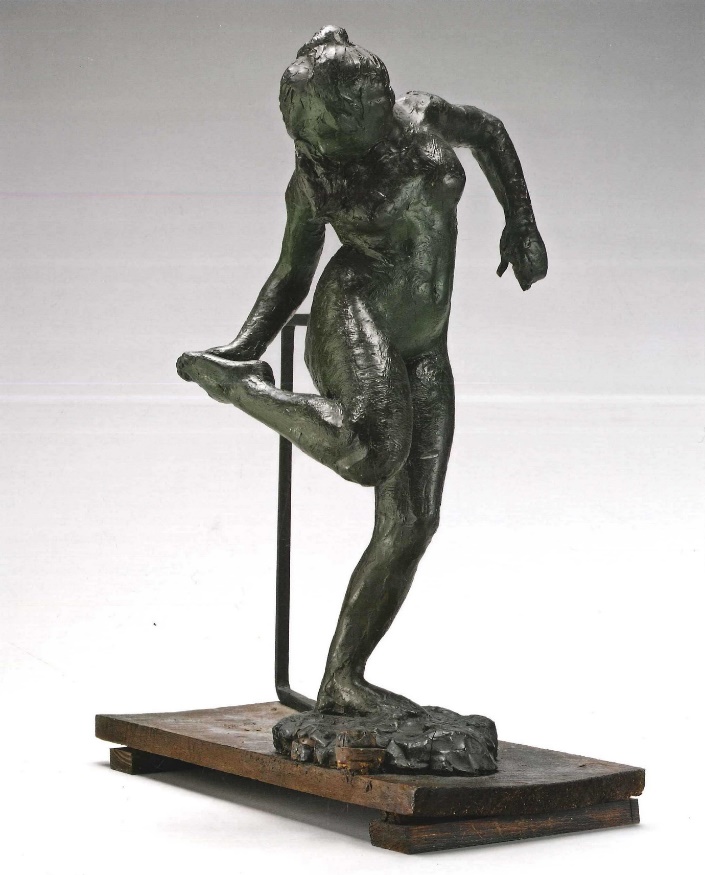
Figure 4.7 Degas, Dancer Looking at the Sole of Her Right Foot. ca. 1890s
4.2.3 Woman Rubbing Her Back with a Sponge, Torso
Woman Rubbing Her Back with a Sponge, Torso (modelled 1880s/ 1890s) (Figure 4.8) is a partial figure that was cast in plaster during Degas’ lifetime with the original sculpture being conceived in clay. The scale of this sculpture is comparable to that of the Little Dancer. Partial figure is an advanced conception for the nineteenth century. Degas’ sculptor contemporary, Auguste Rodin, as mentioned in previous chapter, frequently worked with combining fragments in forming a larger work such as his Iris, Messenger of the Gods and The Walking Man. Rodin has also explored many torso fragments in many postures and sizes in the 1880s while working on the Gates of Hell.

Figure 4.8 Degas, Woman Rubbing Her Back with a Sponge, Torso. Original modelled 1880s/ 1890s, plaster clast by 1917
“Torso, … represents a sculptural snapshot in time that evolved by combining separately modelled pieces of slightly different scale. The arm and upper body are somewhat smaller than the abdomen and truncated thighs. Similarly, the navel is slightly off- centre. A rectangular panel, presumably of the same clay used to model the original sculpture, was added across the middle of the back prior to casting in plaster. It served to blend the upper and lower elements, compensating for the difference in scale.”[73]
Radiographic study of the Torso showed evident of the head being intentionally removed before moulding while the left arm socket was left unfinished. This sculpture amongst all the other sculptures from Degas, reveals the traces of making the most, from its original clay sculpture to the misaligned assemblage of fragments and alternations throughout the process. [74] As suggested by Lindsay, “Degas’ torsos like Rodin’s, assert the eloquence of the mobile trunk rather than the traditional head or limbs.
Degas may not have shared Rodin’s interest in rendering intense psychic states, but his own sculptural torso suggests absorbed focus. Distilled to the zone of activity, this figure confers dignity, through its Greek plastic monumentality, to self- awareness pursued, through touch and sensation, in a mundane personal rite.” [75] Degas chose to render mundane movements in his sculptures, these movements, despite simple, “constitute his riches study of human physicality and its manifestations in modern life”, and embodies the vision of sculpture in the 19th century, where instead of sight as in two- dimensional works, it reaches one’s imagination through “sensation, touch, and three- dimensional physicality”.[76]
5 Rodin and Degas Comparison and Conclusion
It is interesting when comparing the history of Rodin and Degas considering the fact that they were both Parisians, living the same period of history, became sculptors at the same time, and even passed away in the same year. Despite their very different background both in their social classes and the training they received, their stories were indeed subtly connected and even intertwined, which is made visible most directly through their ties to Impressionism. The director ofthe Von der Heydt Museum in Wuppertal stated “Rodin and Degas invented Impressionist sculptures,” and referred to them as "giants of Impressionism" who "raced each other into modernity."[77]
Rodin was often referred to as a self- taught sculptor for despite his long apprenticeship, he took it on himself to study from the ancient and Renaissance work, from which he revitalised the essence of them and adapted them as his working principles, and established his very own, innovative methods in his experimentation of forms and his representation of movement. Despite Rodin claimed kinship to the Impressionist movement[78], he has never identified himself as a part of the group. When analysing his work merely from a technical stand point, his treatment of the broken planes of the surfaces on his work and how it works in different lighting, can be directly related to the nineteenth century Impressionists artists’ broken brushstrokes and facets of colour. However, it is his imperviousness to the academic conventions and his ability to capture movement “alive”, in my opinion, that tied him closely to the group.
When portraying movement, Rodin surpasses the mere pursuit of capturing movement in its anatomy accuracy. His knowledge of the human body allowed him exaggerate volumes so “the air around the sculpture become as agitated as it seemed in real life”[79], meaning Rodin was able to not only capture moving figures in his own kind of realism, but also the atmosphere and the character’s emotions and energy of the moment of the snapshot all at once. Degas, one of the founding members of the Impressionist group, set himself apart from his fellow Impressionist painters due to his different stylistic preferences- such as his preferring artificial lighting over plein air paintings, and his relatively darker, less vibrant colour choices in his painting.
His complex experiments and the mixing of tradition and innovation made him some of the most advanced artists in terms of techniques. Despite some scholars think Degas’ sculptural work has little to do with Impressionism, Selz’s analysis on Degas’ sculpture made it clear how Degas’ work “derived from the same impressionist and expressionist traditions”[80] like Rodin: “Degas’ work represents a rather limited area of sculpture. It has no intellectual pretentions and cannot be regarded primarily as work of the imagination. It is, rather, the work of a keen observer who set out to find a new solution to a consistently thorny problem, that of stabilizing the unstable: movement. His way of moulding the wax, his lack of concern with “finish,” his habit of leaving finger marks on the legs of a dancer or a horse, and his emphasis on the expressive quality of a gesture rather than on the beauty of a shape, are as far removed from the idealistic theories of classical sculpture as from the prosaic goals of realism.
In this respect, and with due allowance made for its modest proportions, his sculpture belongs to the spiritual family of Rodin.” [81] Rodin and Degas, both liberated from the academic convention, found unique balance in old and new techniques, and made significant contributions to the art of sculpture. Whether it is Rodin’s work of lustful or anguished souls in arrested movements and agitated air, or Degas’ work of mundane movements as social and snapshot preserved in amber, these two “giants of Impressionism”[82]- with their works immortalised in bronze- both proved that sculptures can go above and beyond what two-dimensional work is capable of in embodying the core value of Impressionism: capturing fleeting moment through movement and light. In conclusion, I would like to quote my own statement in chapter 1, “The essence of Impressionism is most effective and expressed to its fullest potential in sculptures.”
6 Bibliography
Books
Getsy, david J. Rodin: Sex and the Making of Modern Sculpture. New Haven and London: Yale University Press, 2010.
Hartlaub, G.F. Impressionists in France. Milan: The Uffici Press, 1970.
Lampert, Catherin. Rodin: Sculpture & Drawings. London: Yale University Press on behalf of The Arts Council of Great Britain, 1986.
Lindsay, Suzanne Glover. Edgar Degas Sculpture. Washington DC: National Gallery of Art, 2010.
Pool, Phoebe. Impressionism. London: Thames and Hudson, 1967.
Ritchie, Andrew Carnduff. Sculpture of the Twentieth Century. New York: The Museum of Modern Art, 1953.
Selz, Jean. Modern Sculpture: Origins and Evolution. New York: Heinemann, 1963.
Essays and Articles
Vincent, Clare. “Auguste Rodin (1840–1917).” In Heilbrunn Timeline of Art History. New York: The Metropolitan Museum of Art, 2000. http://www.metmuseum.org/toah/hd/rodn/hd_rodn.htm (October 2004)
Vincent, Clare. “Edgar Degas (1834–1917): Bronze Sculpture.” In Heilbrunn Timeline of Art History. New York: The Metropolitan Museum of Art, 2000. http://www.metmuseum.org/toah/hd/dgsb/hd_dgsb.htm (October 2004)
Samu, Margaret. “Impressionism: Art and Modernity.” In Heilbrunn Timeline of Art History. New York: The Metropolitan Museum of Art, 2000. http://www.metmuseum.org/toah/hd/imml/hd_imml.htm (October 2004)
Schenkel, Ruth. “Edgar Degas (1834–1917): Painting and Drawing.” In Heilbrunn Timeline of Art History. New York: The Metropolitan Museum of Art, 2000. http://www.metmuseum.org/toah/hd/dgsp/hd_dgsp.htm (October 2004)
Rosenfeld, Ph.D., Jason. “The Salon and The Royal Academy in the Nineteenth Century.” In Heilbrunn Timeline of Art History. New York: The Metropolitan Museum of Art, 2000. http://www.metmuseum.org/toah/hd/sara/hd_sara.htm (October 2004)
Finocchio, Ross. “Nineteenth-Century French Realism.” In Heilbrunn Timeline of Art History. New York: The Metropolitan Museum of Art, 2000. http://www.metmuseum.org/toah/hd/rlsm/hd_rlsm.htm (October 2004)
Galitz, Kathryn Calley. “Gustave Courbet (1819–1877).” In Heilbrunn Timeline of Art History. New York: The Metropolitan Museum of Art, 2000. http://www.metmuseum.org/toah/hd/gust/hd_gust.htm (May 2009)
Dege, Stefan. “Two giants of modernity meet: Degas and Rodin”. 2016. http://www.dw.com/en/two-giants-of-modernity-meet-degas-and-rodin/a-36214244
Documentary
Collings, Matthew. “Impressionism: The Revenge of the Nice” (Documentary)
Manson, David. “Edgar Degas: The Great Impressionist” (Documentary)
BBC. “The Private Life of a Masterpiece - Edgar Degas: Little Dancer Aged Fourteen”. 2004. (Documentary)
BBC. “Fine Art Collection 4/7: Rodin (1840- 1917)” (Documentary)
7 Image Sources
Figure 2.1 http://www.metmuseum.org/toah/works-of-art/94.24.1/
Figure 2.2 http://www.metmuseum.org/toah/works-of-art/40.175/
Figure 2.3 http://www.gustave-courbet.com/the-artists-studio.jsp
Figure 2.4 http://www.nationalgallery.org.uk/paintings/edouard-manet-music-in-the-tuileries-gardens
Figure 2.5 http://www.claude-monet.com/impression-sunrise.jsp
Figure 3.1 http://www.musee-rodin.fr/en/collections/sculptures/age-bronze
Figure 3.2 http://www.musee-rodin.fr/en/collections/sculptures/gates-hell Figure 3.3 http://www.musee-rodin.fr/en/collections/sculptures/walking-man
Figure 3.4 http://www.musee-rodin.fr/en/collections/sculptures/i-am-beautiful
Figure 3.5 http://www.metmuseum.org/art/collection/search/207567
Figure 3.6 http://www.musee-rodin.fr/en/collections/sculptures/crouching-woman-also-known-lust
Figure 3.7 http://www.metmuseum.org/toah/works-of-art/1989.407/
Figure 4.1 http://www.metmuseum.org/toah/works-of-art/1987.47.1/
Figure 4.2 http://www.arthermitage.org/Edgar-Degas/Place-de-la-Concorde.html Figure 4.3 Lindsay, Suzanne Glover. Edgar Degas Sculpture. Washington DC: National Gallery of Art, 2010. P. 117
Figure 4.4 http://www.wga.hu/html_m/d/dubois_p/f_singer.html
Figure 4.5 Lindsay, Suzanne Glover. Edgar Degas Sculpture. Washington DC: National Gallery of Art, 2010. P. 118
Figure 4.6 Ibid. P. 116
Figure 4.7 Ibid. 227
Figure 4.8 Ibid. 267
Cite This Work
To export a reference to this article please select a referencing stye below:
Related Services
View allRelated Content
All TagsContent relating to: "International Studies"
International Studies relates to the studying of economics, politics, culture, and other aspects of life on an international scale. International Studies allows you to develop an understanding of international relations and gives you an insight into global issues.
Related Articles
DMCA / Removal Request
If you are the original writer of this dissertation and no longer wish to have your work published on the UKDiss.com website then please:




